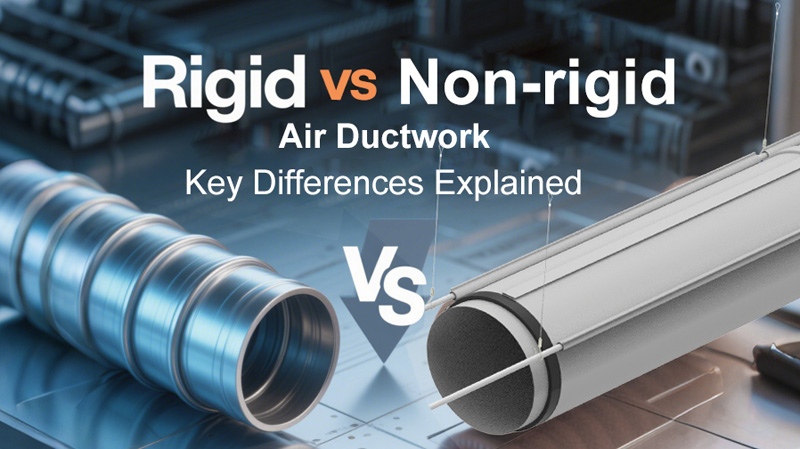 How Durkee Smart HVAC Innovations Take Center Stage at China Refrigeration 2025
How Durkee Smart HVAC Innovations Take Center Stage at China Refrigeration 2025
 Advantages and Prospects of Cloth Air Ducts
Advantages and Prospects of Cloth Air Ducts
 Fabric Duct: Innovator of Flexible Ventilation Systems
Fabric Duct: Innovator of Flexible Ventilation Systems
When designing an HVAC system, one of the most critical decisions lies in choosing between rigid and non-rigid air ducts. At Durkee, we specialize in Durkduct non-rigid air duct solutions, including fabric-based systems and pre-insulated composite air ducts, which deliver superior performance across a wide range of applications. This comprehensive guide will analyze the key differences between these two duct types and demonstrate why non-rigid air ducts are emerging as the preferred choice for modern ventilation systems.

Rigid air ducts are the traditional choice for HVAC systems, typically made from materials like:
Galvanized steel
Aluminum
Fiberglass
Rigid plastic (PVC)
These ducts maintain their shape under pressure and are known for their durability in harsh environments. However, they come with several limitations that non-rigid air ducts can overcome.
Non-rigid air ducts, like the innovative fabric and pre-insulated composite solutions from Durkduct, offer numerous benefits:
Unlike air duct products that require precise measurements and custom fittings, non-rigid air ducts can adapt to various spaces. This flexibility significantly reduces installation time and costs.
Our fabric non-rigid air ducts provide even, draft-free air distribution through micro-perforations, eliminating hot/cold spots common with metal duct systems.
Weighing up to 90% less than metal ducts, Durkduct's non-rigid solutions reduce structural support requirements and simplify handling.
Fabric ducts resist microbial growth and don't accumulate dust or condensation, making them ideal for food processing, healthcare, and cleanroom applications.
The insulating properties of our fabric materials help maintain air temperature, reducing energy consumption compared to traditional sheet metal ducts.
Feature | Traditional Rigid Air Duct | Durkduct Non-Rigid Air Duct |
Air Distribution | Concentrated airflow | Even, diffuse airflow |
Installation Time | Longer | Up to 70% faster |
Weight | Heavy (5-20 lbs/ft) | Light (0.5-2 lbs/ft) |
Condensation Risk | High | Minimal |
Noise Transmission | Moderate | Very low |
Maintenance Requirements | Regular cleaning needed | Low maintenance |
Customization Options | Limited | Highly customizable |
As a leading fabric duct manufacturer, Durkduct offers non-rigid air duct systems like fabric air ducts that outperform traditional rigid ducts in many applications:
Custom Fabric Options: Choose from various materials tailored to your specific airflow, temperature, and hygiene requirements.
Easy Retrofit: Our systems can often be installed within existing structures without major modifications.
Visual Appeal: Available in multiple colors and designs that blend with your space aesthetics.
Longevity: High-quality materials ensure a lifespan comparable to metal ducts without corrosion issues.
Sustainability: Fully recyclable materials and reduced energy consumption support green building initiatives.
From cutting-edge cleanrooms to high-stakes energy facilities, non-rigid air ducts are redefining industrial HVAC efficiency.
New Energy Battery Manufacturing Facilities
Photovoltaic Wafer & Module Plants
Semiconductor & Electronics Cleanrooms
Warehouses & Logistics Hubs
Commercial Convention Centers
Gymnasiums & Sports Facilities
Indoor Pools & Aquatic Centers
While rigid ducts still have their place in high-temperature or high-pressure applications, non-rigid air ducts from Durkduct offer compelling advantages for most commercial and industrial ventilation needs. Our fabric-based and pre-insulated air duct systems provide better air quality, easier installation, and lower lifecycle costs than traditional metal ducts.
For help determining whether non-rigid air ducts are right for your project, contact the experts at Durkduct today. As an innovative fabric duct manufacturer, we can design a customized duct sock for sale that meets your exact specifications while delivering superior performance and energy efficiency.
Discover the Durkduct difference - where innovative non-rigid air duct technology meets exceptional air distribution performance. Request a consultation today to experience the future of HVAC ductwork.